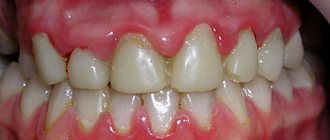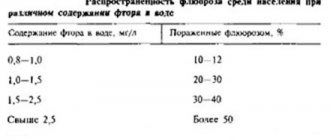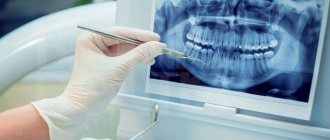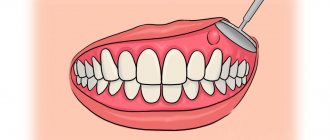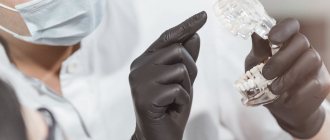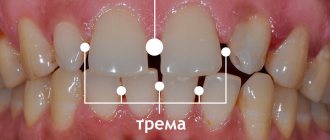Polyps in the throat have many manifestations; the most commonly diagnosed are benign neoplasms located on the tonsils and vocal cords. The period of polyp growth can last up to several years, so when they appear, you should contact a specialist to undergo diagnostics and determine treatment tactics.
When patients come to the Yusupov Hospital with any symptoms of this disease, the oncologist conducts an examination and prescribes diagnostic procedures to identify the shape, size and location of polyps. After examination, polyps in the throat are quickly and painlessly removed by surgeons.
Causes of development of polyps in the throat
Experts have identified many factors that provoke the development of polyps in the throat, but the causes of this disease have not been fully studied. Polyps on the throat ligaments, tonsils and larynx develop as a result of the following reasons:
- allergic reactions, the source of which cannot be eliminated;
- regular overstrain of the vocal cords when singing, shouting, whispering;
- drinking alcoholic beverages and coffee that irritate the mucous membrane;
- smoking;
- inhalation of heavy metal impurities during work;
- hereditary predisposition;
- dysfunction of the thyroid gland.
An oncologist at the Yusupov Hospital, when a patient comes in with this problem, conducts an examination and determines whether it is dangerous to leave a polyp in the throat unattended, and what methods are necessary to treat it.
Benign tumors of the oral cavity
Fibroids . Oral fibroids are most common in the lower lip, tongue, and palate. They look like a smooth oval or round formation, in some cases located on a stalk. The color of these oral cavity tumors does not differ from the color of the surrounding mucosa.
Fibromatosis of the gums . Not all authors classify gingival fibromatosis as a tumor of the oral cavity; some believe that it is based on inflammatory changes. Fibromatous growths are painless, dense formations. They can be local in nature within several teeth or diffuse, involving the entire alveolar process of both the lower and upper jaw. Tumor growths in fibromatosis are localized in the gum papillae and can be so pronounced that they completely cover the crowns of the teeth. This type of oral tumor requires differentiation from hyperplastic gingivitis.
Myomas . Develop from muscle tissue. Rhabdomyomas are formed from fibers of striated muscles. Most often they are observed in the form of single nodular formations in the thickness of the tongue. Leiomyomas develop from smooth muscle fibers and are usually located on the palate. Myoblastomas (Abrikosov tumor) are the result of disembryogenesis and are diagnosed in children under one year of age. They are a round tumor of the oral cavity up to 1 cm in size, covered with epithelium and having a shiny surface.
Myxomas . These oral tumors may have a round, papillary, or bumpy surface. They are located in the area of the hard palate or alveolar process.
Pyogenic granuloma
. Develops from the mucous or connective tissue elements of the oral cavity. Often observed after injury to the mucous membrane of the cheeks, lips or tongue. Pyogenic granuloma resembles richly supplied granulation tissue. It is characterized by a rapid increase in size up to 2 cm in diameter, dark red color and bleeding when touched.
Epulis . Benign tumors of the oral cavity located on the gums. They can grow from the deep layers of the gums, periosteum, and periodontal tissues. Epulis occurs most often in the area of the front teeth. They are classified into fibrous, giant cell and angiomatous formations.
Neuromas
. They are formed as a result of the proliferation of Schwann sheath cells of nerve fibers. They reach 1 cm in diameter. They have a capsule. Neuromas are practically the only tumors of the oral cavity that may be painful on palpation.
Polyps in the throat: photos and descriptions of tumors
Polyps in the throat, the symptoms of which depend on the size and location of the tumor, are formed by connective tissue, cellular elements and a small amount of fluid. Polyps are located in the throat on a thick stalk; they can have a white, pink or gray tint.
Some people who exhibit symptoms of this disease look at the laryngeal polyp in the photo and study the characteristic signs. Oncologists and otolaryngologists recommend not to carry out independent treatment of tumors, as it can cause chronic sore throat, infectious processes and irreversible changes in the voice.
The Yusupov Hospital uses modern methods for treating laryngeal polyps, which have successfully proven themselves in world medical practice. Highly qualified specialists remove the laryngeal polyp painlessly.
Material and methods
The material for the study was samples of vocal fold polyposis tissue obtained by endolaryngeal microsurgical method from 31 patients (13 men, 18 women) aged from 23 to 75 years, operated on for vocal fold polyposis in the period from 2008 to 2012. The vast majority were individuals those experiencing increased vocal stress (teachers, vocalists, command staff, etc.). In the anamnesis, 19 patients had a history of household intoxication (tobacco smoking), and 7 had a history of occupational chemical exposure. Among them, 7 cases were clinically diagnosed as angiomatous polyps of the vocal fold, edematous polyposis laryngitis (Reinke's edema) - 7, vocal fold polyps (unspecified form) - 13, multiple polyps of the vocal folds (unspecified form) - 4.
All material was fixed in neutral formalin and embedded in paraffin according to the generally accepted method. For the morphological study of histological sections 5-7 µm thick, in addition to survey methods of hematoxylin and eosin staining, special methods were used (van Gieson staining, Alcian blue staining, PAS reaction). In parallel, immunohistochemical reactions were carried out using diagnostic mono- and polyclonal antibodies to the desired antigens that determine the structural and biochemical organization of the polyp. The work used the main differentiation markers of T- and B-lymphocytes (CD3, CD4, CD8 and CD20, CD79a, respectively, “DAKO”), the regulatory coreceptor of T-lymphocytes molecule B7−1 (CD80, Epitomics), macrophages (CD68, “ DAKO"), high molecular weight cytokeratins (clone 34βE12, DAKO), markers of toll-like receptors (TLR2, TLR4, TLR9, LifeSpan BioSciences), markers of endothelium and matrix metalloproteinases, allowing the assessment of angiogenesis (CD34, Euro-Diagnostica ), vascular permeability and remodeling of the connective tissue matrix (VCAM-1, MMP-1, MMP-9, BioGenex, Novocastra, DAKO). The studies were carried out according to the patented protocols of the indicated antibody manufacturers. To visualize the reactions, ready-made test systems with universal secondary antibodies labeled with chromogen (HRP-polymer Detection system, BioGenex) were used. Positive results of histochemical reactions were taken into account in the presence of two negative (for the specificity of the reaction and the absence of endogenous peroxidase activity) and one internal positive (for specificity) controls.
After histological examination, all polyp tissue samples were divided into 3 groups. The 1st group consisted of 15 observations of edematous polyps of the vocal folds, among them 4 samples had a transitional structure and were classified as edematous-angiomatous polyps; in one observation, the edematous polyp was distinguished by pronounced myxomatosis of the stroma (myxoid polyp). Group 2 consisted of 11 cases of angiomatous polyps of the vocal folds; Group 3 included 5 cases of edematous polyposis laryngitis (Reinke-Hajek's edema).
Polyps in the throat: symptoms of the disease
Symptoms of polyps in the throat can be combined with manifestations of the underlying disease. Without exacerbation under the influence of negative factors, polyps do not appear in any way, so they may not be detected by patients for a long time.
With increasing polyps and frequent trauma, tears may occur, which worsen the patient's condition. A laryngeal polyp may have the following manifestations:
- pain when the vocal cords are tense;
- hoarseness of voice;
- feeling of a foreign summer;
- increased salivation;
- cough mixed with blood;
- pain syndrome in the neck area.
The Yusupov Hospital employs experienced oncologists who, when examining patients who complain, identify tumors in the throat. When visiting an oncology clinic, a patient can quickly and comfortably undergo an examination without queues at a convenient time by appointment.
Localization
The location of polyps in the mouth area may vary. The tumor can be located on the inner surface of the cheeks and lips, in the sublingual area, or on the tongue.
Location on cheeks
Polyps on the cheeks can reach impressive sizes, interfere with the chewing process, and are constantly injured by teeth when grinding food. Such neoplasms often bleed, are prone to generalized spread, and are distinguished by a variety of forms and morphological structure.
Localization on the palate
When large polyps are located on the surface of the upper or lower palate, the swallowing process is disrupted and it becomes difficult to grind food when chewing. Often the pathological process tends to spread.
Any localization of polyps in the mouth is accompanied by serious risks:
- traumatization,
- bleeding,
- infections,
- association with various diseases of the mucous membranes.
Polyp in the throat: treatment
Modern specialists offer various ways to treat polyps in the throat. Drug therapy can improve the general condition of the patient, but it does not ensure the resorption of polyps. If a patient is found to have polyps in the throat, the symptoms and treatment of which depend on the size of the tumor, the oncologist at the Yusupov Hospital selects the most gentle and effective methods for eliminating them.
Polyps localized on the mucous membrane of the tonsils, vocal cords and larynx require surgical removal. For small polyps in the throat, minimally invasive techniques are used, allowing the patient to return to active life on the day of surgery.
If treated incorrectly, there is a high risk of relapse. To eliminate tumors in the throat, you should contact highly qualified specialists at the Oncology Clinic of the Yusupov Hospital, who will perform high-quality surgical removal of the polyp.
Diagnostic measures
If you experience discomfort in the mouth area, you should conduct a self-examination. To do this, you will need to open your mouth wide, provide good lighting and examine the condition of the pharynx in the mirror. If necessary, you can use a small mirror to reflect hard-to-reach places (for example, the inner surface of the cheeks).
A professional examination is considered to be a dental examination using special instruments. The doctor will assess the condition of the oral cavity, exclude abscesses and cysts, especially if polypous lesions are localized in the gingiva.
In the absence of obvious dental problems, the patient is referred for consultation to a therapist and oncologist.
On examination:
- palpate regional lymph nodes,
- an ultrasound examination is prescribed,
- x-ray,
- MRI or CT diagnostics.
These methods make it possible to assess the degree of proliferation of the mucous membranes and determine the malignancy of the tumor at the earliest stages. An important examination is a biopsy of polypous lesions in the mouth and histological examination.
Among additional tests, it is necessary to collect urine, blood, and feces to exclude various diseases that could serve as a trigger for the formation of polyps. Often, eliminating the cause of the formation of polypous lesions promotes their independent “resorption.”
An important aspect in diagnosis is the study of the patient’s clinical and life history. If close relatives have oral cancer, a mandatory histological examination for cell atypia is required.
Removal of a polyp in the throat: price
The cost of surgical treatment of a polyp in the throat depends on the method of intervention, stage and other factors. The price of this service is determined after a comprehensive diagnosis in accordance with the current price list at the Yusupov Hospital. Each patient has the opportunity to receive complete information about the scope of treatment measures and their cost.
For patients diagnosed with throat polyps, oncologists develop an individual treatment plan. The key to high quality medical services provided to patients at the Yusupov Hospital is an integrated approach to solving this problem.
Diagnostics
Often, diagnosis at home is complicated by the inaccessibility of the oral cavity, so the exact location of the polyp and its nature can only be found out at an appointment with a specialist after direct laryngoscopy.
Direct laryngoscopy is a diagnostic examination method using a special device - a fibrolaryngoscope. It is a flexible tube with an optical system at the end, the image from which is displayed on a monitor.
During this study, a specialist can examine the oral cavity, take part of the material for a biopsy, and, if there is a small tumor, remove it on the spot.
It is important to understand that this diagnostic procedure may cause some inconvenience, so the patient is not recommended to eat or drink water before laryngoscopy. For the same reason, before inserting the device, the pharynx is sprayed with an anesthetic and a certain amount of medication is injected into the body, partially blocking the secretion of mucus.
Next, while the patient is lying down, a fibrolaryngoscope is inserted through the nose to the required level, while the tongue is held with a special spatula. Then the doctor assesses the condition of the oral mucosa and pharynx.
If necessary, after detecting a small polyp, it is removed and the base is cauterized. The last manipulation is carried out with the aim of coagulating blood vessels and preventing relapse of tumor growth. The body of the polyp is removed and sent for additional histological examination.
